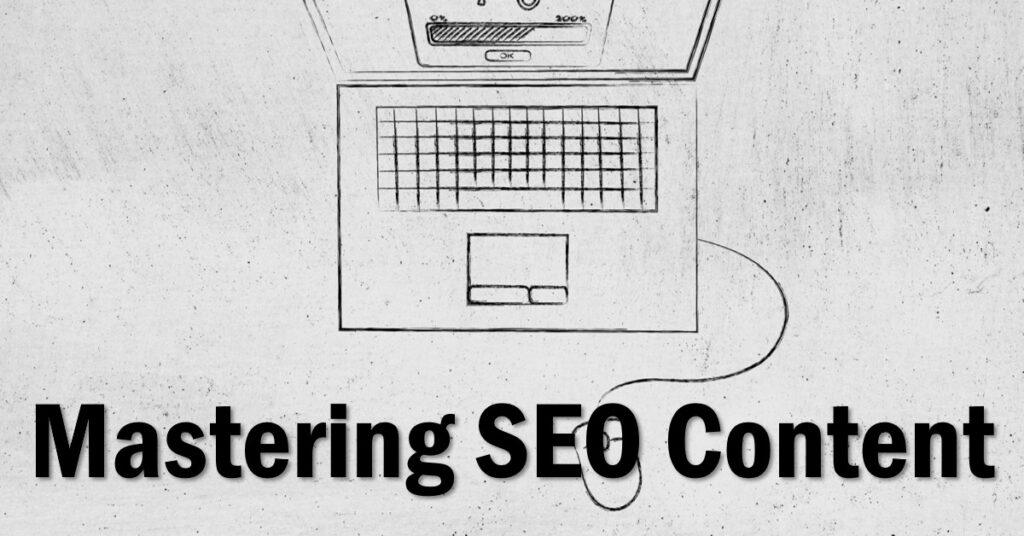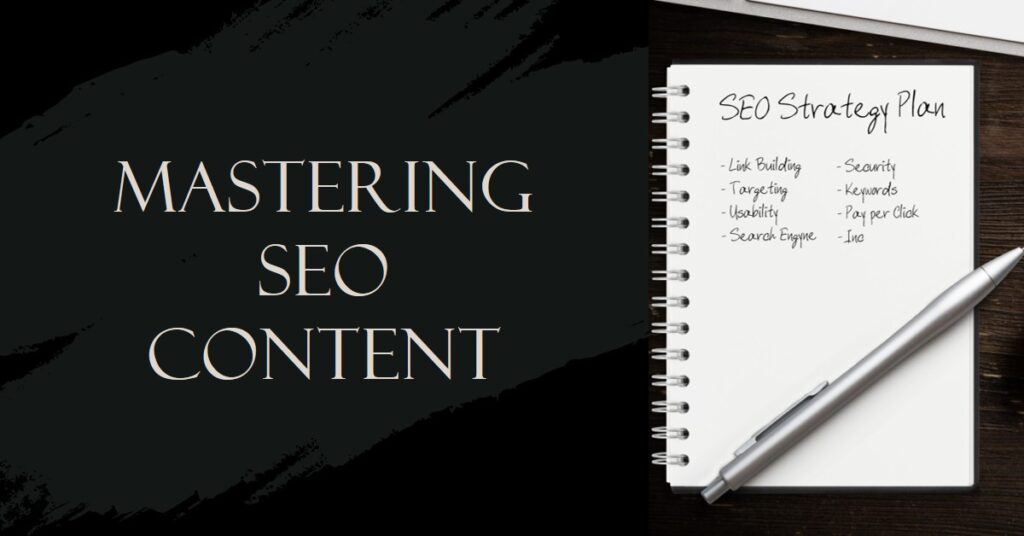- Importance of SEO content
- Understanding keywords and their role in SEO content
- Writing SEO-friendly content
- Optimizing website structure for SEO content
- Promoting SEO content
- Monitoring and evaluating the performance of SEO content
- Conclusion: The importance of ongoing optimization and updates to SEO content.
- Frequently Asked Questions
SEO content is essential for boosting website visibility and driving organic traffic. Crafting compelling, keyword-rich content is key. Strategically incorporate relevant keywords, optimize meta tags, and structure content correctly to help websites rank higher. Quality is paramount – not just stuffing keywords. Craft engaging and informative content that connects with the target audience.
User experience is also vital. Search engines analyze bounce rate, time spent on site, and page loading speed to determine relevancy and usability. Optimize web design and ensure fast load times for a seamless browsing experience.
SEO strategies must constantly evolve; what worked yesterday won’t necessarily work tomorrow. Algorithms update to provide relevant and helpful results. Stay up-to-date and adapt strategies accordingly to maintain a successful online presence.
For an example of the power of SEO content, let’s look at XYZ Company. They were struggling to attract website visitors despite their impressive product lineup. So, they invested in optimizing their website’s content for search engines. After thorough keyword research and rewritten product descriptions, they saw an influx of targeted visitors within months. This translated into higher sales and increased brand visibility in their niche market.
Importance of SEO content
To enhance your understanding of the importance of SEO content, delve into the benefits it offers. Discover how utilizing SEO content can boost your website’s visibility, drive organic traffic, improve search engine rankings, increase brand credibility, and enhance user experience. Each of these sub-sections holds valuable insights into maximizing the potential of your online presence.Benefits of using SEO content
Using SEO content has many benefits to a website. Here are six key advantages:
- Better visibility: SEO content boosts your website’s rank in search engine results, so more people can see it.
- More traffic: With higher rankings, you’ll get more organic visitors to your site, creating more sales opportunities.
- Targeted audience: You can use relevant keywords to attract visitors searching for specific products or services.
- Improved user experience: SEO content gives valuable info that’s easy to find, giving visitors a good browsing experience.
- Long-term effects: SEO content continues driving traffic and generating leads long after the investment.
- Cost-effective: SEO costs less than other online marketing strategies, making it perfect for limited budgets.
Other benefits of SEO content include staying ahead of competitors, establishing credibility, and increasing brand awareness. Remember to prioritize quality over quantity when creating SEO content. Search engines can be tricky; know where to look for keywords and you’ll win the visibility game.
Understanding keywords and their role in SEO content
To understand keywords and their role in SEO content, incorporate these sub-sections: How to conduct keyword research, and Choosing the right keywords for your content.How to conduct keyword research
Keyword research is a must for SEO content. To do it well, follow these 3 steps:
- Know your audience and aims: Understand who your target audience is, and what keywords they’d likely use to look for the content you offer. Set clear goals for your SEO strategy that match your business objectives.
- Use keyword research tools: Make use of reliable keyword research tools like Google Keyword Planner, SEMrush, and Moz Keyword Explorer. Generate a list of related keywords and analyze their search volume and competition level. Pick the most suitable ones for your content.
- Analyze competitor keywords: Investigate which keywords your competitors are targeting successfully. This can give you ideas for potential keywords you may have missed. Find gaps to differentiate yourself from competitors, by targeting unique keywords.
Long-tail keywords can be useful too, as they usually have less competition and bring more targeted traffic. Remember, keyword research is an ongoing process since trends and user behaviour change.
Ahrefs’ study shows that 90% of web pages don’t get organic traffic from Google. So, doing good keyword research is key for getting to the top of SERPs.
Think of it as picking the ideal crime partner – you want someone who helps you reach the top of search engine rankings.
Choosing the right keywords for your content
Choosing the right keywords is essential for effective SEO content. It’s key to pick relevant keywords that fit user intent and search volume. Here’s how to find the best keywords:
| Keyword Research | Identify potential keywords with tools like Google Keyword Planner or SEMrush. Focus on long-tail keywords to target specific audiences and boost your chances of higher ranking. |
| Search Volume | Check the search volume for each keyword to see how popular it is. Opt for keywords with a decent search volume so your content reaches more people. |
| Competition Analysis | Examine the competition for each keyword by looking at the top-ranking pages. Choose keywords with low competition but still good search volume. |
| Relevance | Make sure the chosen keywords are very relevant to your content topic. This helps in improving user experience and organic traffic by drawing users who are genuinely interested in your offerings. |
| Long-Term Goals | Take your long-term goals into consideration when selecting keywords. Optimize your content around keywords that align with your business objectives, such as driving sales, generating leads, or increasing brand awareness. |
Besides these main points, it’s useful to note some lesser-known details about keyword choice:
- Use variations: Include synonyms and related terms of your primary keyword to capture different search queries and expand your reach.
- User intent: Figure out the user intent behind certain searches and personalize your content accordingly. This helps to better match what readers are looking for.
- Trend analysis: Keep track of trending keywords related to your industry and create content around them. This can give your website an edge and bring more organic traffic.
Pro Tip: Regularly review and update your keyword strategy based on the performance of your content. Stay informed with industry trends and adjust your keywords to remain high in search rankings.
Finding the perfect keywords is like finding the perfect readers – it takes finesse, strategy, and a bit of wit!
Writing SEO-friendly content
To optimize your content for search engines, craft SEO-friendly content using effective strategies. Start with creating engaging and informative headlines, incorporating keywords naturally throughout the content, organizing using headings and subheadings, and utilizing meta tags and meta descriptions. These sub-sections will help you boost your content’s visibility and reach a wider audience.Creating engaging and informative headlines
Make your words powerful! Use adjectives and verbs that will grab attention and show the value of your content.
Be concise and clear. Short phrases that explain the article are best. Avoid long, confusing sentences.
Relevance is key. Make sure your headline speaks to your audience’s needs and interests.
Include keywords strategically. Research the best keywords related to your topic and use them in your headline. This will improve your SEO.
Remember, creativity and precision are essential for a great headline. Now you know how to create engaging headlines – use these tips and watch your readership grow!
Incorporating keywords naturally throughout the content
Research keywords related to your topic for successful content. Place those keywords strategically throughout; headings and subheadings, the first paragraph, variations, image alt tags, and meta descriptions. But, don’t overdo it – search engines don’t like keyword stuffing. Focus on providing valuable, informational content readers will enjoy. Make sure the content is organized – even search engines appreciate this!
Organizing content using headings and subheadings
Organizing Content with Headings and SubheadingsMaking use of headings and subheadings to organize content has several benefits:
- It makes it simpler for readers to explore the content and comprehend the main points.
- It enhances the SEO optimization of your webpage, as search engines identify the hierarchical structure and significance of the info.
According to Search Engine Journal, orderly content with headings and subheadings improves user experience by allowing them to rapidly scan through the page and locate the information they need. It also states that writing SEO-friendly content is less dangerous than solving a murder mystery!
Clear and ConciseTo improve readability:
- Keep paragraphs short and divide content into smaller sections.
Utilize appropriate hierarchy of headings and subheadings to organize your content.
Improves ReadabilityBreak down content into manageable sections for easier consumption.
Using meta tags and meta descriptions
Meta tags and meta descriptions are vital for optimizing your content for search engines and enhancing your website’s visibility. By using these elements strategically, you can increase your webpage’s ranking on SERPs and get more organic traffic.
Meta tags and descriptions have major SEO benefits:
- – They provide search engines with info about the webpage’s content. For example, the title tag is displayed as the clickable headline on SERPs. The meta description tag summarises the webpage in a few words. Writing relevant and intriguing meta tags can draw people to your webpage.
- – Including the right keywords in your meta tags helps search engines understand what your webpage is about, making it more likely to appear in relevant searches. But don’t overstuff them.
- – Meta descriptions should be written to attract users and make them click on your webpage. They should be accurate and persuasive in comparison to other search results. Well-crafted descriptions can significantly boost CTR.
- – Length is key when writing meta descriptions. Keep them between 50-160 characters for full visibility across different devices. Anything longer may get truncated, affecting user engagement.
- – Regularly updating and optimising your meta tags and descriptions is essential to stay up-to-date with evolving SEO trends and algorithms. By monitoring keyword performance and ensuring relevance, you can keep or improve your webpage’s ranking.
Remember that meta tags aren’t visible on the webpage itself, but embedded in the HTML code. Visitors won’t see them directly, but will feel their effect indirectly through better search engine rankings.
To get the most out of meta tags and descriptions:
- – Use relevant keywords naturally in your meta tags.
- – Create enticing and concise meta descriptions that accurately portray the webpage’s content.
- – Keep the length of your meta descriptions within the recommended range.
- – Refresh and optimise your meta tags based on keyword performance and SEO trends.
Forget missing out on maximizing your website’s visibility and gaining more organic traffic. Start using the power of meta tags and descriptions now!
Optimizing website structure for SEO content
To optimize your website structure for SEO content, solve the problem by focusing on the importance of a well-structured website, creating user-friendly URLs, and optimizing images and multimedia content. These sub-sections will help you make your website more search engine-friendly and improve your overall SEO strategy.Importance of a well-structured website
A well-structured website is essential for SEO success. Its layout, organization, and navigation all affect search engine visibility. Good structure helps search engine algorithms to crawl and index pages, leading to higher SERP rankings. It also makes it easier for users to find content.
To optimize website structure, HTML tags and elements should be used. This includes headings, meta tags, image alt tags, and semantic markup. These help search engines understand content better. Plus, internal links can help distribute authority within the site. Anchor text can enhance readability and create topic clusters.
For example, “Pawfect Paws” reorganized their website structure to boost SEO performance. They grouped products into categories instead of alphabetical order. This made it easier for customers to find what they wanted. As a result, organic traffic and conversions increased.
Creating user-friendly URLs
Check out these tips for creating user-friendly URLs!
Structure:
- Use words that explain the page content.
- Skip long strings of numbers/letters.
- Separate words with hyphens.
Keywords:
- Include keywords in the URL.
- Don’t stuff keywords.
- Get a good balance between keywords and natural-sounding URL.
Length:
- Keep URLs short.
- Long URLs can be off-putting.
Hierarchy:
- Structure URLs to match the website layout.
- This helps search engines navigate.
Redirects:
- Handle redirects when changing URL structures.
- Use 301 redirects to send visitors to the new URL.
These guidelines will help you create user-friendly URLs that are easy to remember, and help your SEO efforts. Don’t forget other SEO opportunities like multimedia content! Get on it!
Optimizing images and multimedia content
Pick the right file format: Choose JPEG, PNG for regular images, GIFs for animations, and SVG for vector graphics.
Compress your pics: Reduce file size with tools like Photoshop or TinyPNG, without losing quality.
Optimize alt text: Use concise keywords in alt text to accurately describe images for SEO.
Include captions: Captions provide context and can include relevant keywords for SEO.
Lazy loading: Prioritize visible content first and load off-screen media when needed.
Reduce multimedia: Try to reduce elements that slow down loading times or distract.
Get out there: Get your SEO content out there for an improved experience and top search engine spot! Start today!
Promoting SEO content
To enhance the visibility of your SEO content and boost your search engine rankings, focus on promoting it effectively. Building backlinks, utilizing social media, and engaging with your audience through comments and discussions are key strategies to consider. These sub-sections provide solutions for improving the reach and impact of your SEO content.Building backlinks to improve search engine rankings
Constructing backlinks is essential to enhance search engine rankings. These links serve as votes of trust from other websites, telling search engines your content is valuable and dependable. When you build high-quality backlinks, search engines are more likely to place your website higher in search results.
Six tips to remember when building backlinks:
- Guest blogging: Compose informative and engaging posts for other websites in your industry. Include a link back to your own website within the content and entice readers to visit for more information.
- Outreach: Get in touch with influencers, bloggers, and webmasters who have an audience interested in your niche. Propose collaborative projects or ask them to link back to one of your top-notch articles.
- Social media shares: Share your content on social media platforms with a powerful call-to-action asking users to share it with their followers. This could result in more visibility and possibly create backlinks from people who find your content helpful.
- Internal linking: Ensure there are pertinent internal links inside each piece of content on your website. This helps search engines discover other useful pages on your site and improves overall visibility.
- Broken link building: Spot broken links on popular websites in your industry and contact the webmasters offering alternative resources from your own site that they could substitute the broken links with.
- Directory listings: Submit your website to reputable online directories to generate backlinks as well as increase the exposure of your business for potential customers.
It’s crucial that all these backlinks come from authoritative websites within your industry, as low-grade or shady links can do more harm than good.
In addition to these tactics, frequently monitoring and updating old content can also help improve search engine rankings by ensuring that all connected resources are still active and relevant.
Don’t miss out on the advantages of setting up quality backlinks! Begin utilizing these strategies today and observe as your search engine rankings skyrocket. If your content isn’t noticed on social media, did it even exist?
Utilizing social media for content promotion
Social media is a great way for businesses to get their SEO content seen. Platforms like Facebook, Instagram, and Twitter are key to boosting online visibility. Content creators should make sure to create shareable content that speaks to their target audience. This will encourage users to engage and share, stretching the reach of the material.
Collaborating with influencers who have an engaged following in your niche can also be beneficial. Their endorsement of your material can increase credibility and broaden your reach.
Analyzing metrics like engagement rate, click-through rate, and conversion rate can help fine-tune strategies for optimal results.
The success stories are out there too! A startup company got millions of followers with their viral videos. This, in turn, led to more website traffic and rapid growth.
Engaging with the audience through comments and discussions is a must for successful content promotion.
Engaging with the audience through comments and discussions
Comments allow users to share their thoughts and provide feedback. It’s important to respond to them promptly and thoughtfully to show appreciation and engage with others’ viewpoints. This helps demonstrate expertise and build trust among your audience. Responding to comments benefits everyone and encourages participation.
When creating blog posts or social media updates, consider posing open-ended questions to engage readers and encourage them to share their opinions. Additionally, it’s important to moderate comments to ensure a safe environment for everyone.
Another key aspect of interacting with your audience is maintaining professionalism. Use an informative tone and share meaningful stories to connect with your readers. An example of this is when I posted an article on SEO best practices. A reader asked for clarification, and I replied with personalized advice. This not only resolved their query but also sparked a lengthy discussion, attracting more readers and increasing website traffic.
It’s also crucial to monitor and evaluate the performance of your SEO content. This allows you to identify areas of improvement and ensure that your content continues to perform well.
Monitoring and evaluating the performance of SEO content
To maximize the effectiveness of your SEO content, you need to monitor and evaluate its performance. Use analytics tools to track website traffic and keyword rankings, and make adjustments based on data and feedback. This will ensure that your content is continuously optimized for better results.Using analytics tools to track website traffic and keyword rankings
Analytics tools are essential for SEO content performance monitoring and evaluating. They can track website traffic and keyword rankings. Here are six key ways to use analytics tools:
- Track website traffic patterns. Analyze number of visitors, unique visitors, and their actions on different pages.
- Analyze keyword rankings. Monitor how target keywords are performing in search engine rankings. Notice any fluctuations and adjust content.
- Measure click-through rates (CTR). Evaluate the effect of meta titles and descriptions to attract users to click on website in search results.
- Identify top-performing pages. Find out which pages drive the most traffic and engagement. Copy their success in other areas.
- Monitor bounce rates. Discover pages with high bounce rates. Optimize content or design elements for better user experience.
- Segment data by demographics. Understand demographic info like age, gender, location, etc. Use this to tailor content strategy.
Check data accuracy regularly. Make custom reports that provide insights into specific metrics. With analytics tools, businesses can make data-driven decisions, leading to better SEO performance.
A company discovered the value of analytics tools for tracking website traffic and keyword rankings. They kept optimizing content based on assumptions. After integrating analytics tools into their strategy, they saw some keywords were performing poorly, and others were underutilized. They redirected efforts towards keyword optimization with actual data. This resulted in more organic traffic and conversions. This case shows the immense value of these tools.

Remember: Your content is like a bad haircut; it can always be fixed with a little trimming and styling.
Making adjustments based on data and feedback
- Analyze data to spot patterns and trends in user behavior. This can guide you to adjust better to audience preferences.
- Refine keyword strategy by using more high-performing keywords and dropping low-performing ones. This keeps content optimized for search engines.
- Pay attention to user feedback to see what content needs improvement. Modify the content as needed to address any concerns or suggestions.
- Continuous testing and experimentation is a great way to make adjustments. Try different strategies and monitor their results to optimize SEO content better.
- Monitor website analytics to stay on top of key metrics like click-through rates, conversion rates, and bounce rates. Analyzing this data will make your SEO performance soar!
- The more you maintain your website, the better it gets – it’s like a fine wine. Keep your competitors crying sour grapes!
Conclusion: The importance of ongoing optimization and updates to SEO content.
Optimizing and updating SEO content is key for gaining online visibility and organic traffic. Refining and enhancing your SEO strategy helps you stay ahead of the competition.
Regular updates to SEO content keep it relevant to the ever-changing search engine algorithms. This helps search engines crawl and index your website better, boosting its ranking. Trending keywords and phrases make your content more visible, drawing in more targeted traffic.
Analyzing user behavior and search trends is also important for ongoing optimization. Keeping track of metrics like click-through rates, bounce rates, time on page, and conversions gives insights into how your SEO content performs. This data helps decide which elements need improvement or modification.
To optimize your SEO content:
- Do thorough keyword research – Find keywords that match your audience’s search intent. Use Google Trends or SEMrush to know trending terms.
- Create quality content – Write engaging, informative articles that benefit readers. Structure content well, make it easy to read, and use headings and subheadings.
- Optimize meta tags – Compose meta titles and descriptions that accurately reflect the page content. Include relevant keywords, keeping them short.
- Build authoritative backlinks – Get high-quality backlinks from reliable websites within your industry. This improves website credibility and search engine recognition.
By following these suggestions, you can ensure ongoing optimization for SEO content. Monitor performance and adjust strategy based on analytics data. Keep up with industry trends to stay competitive in the online marketplace.
Frequently Asked Questions
Question 1: What is SEO content?
Answer: SEO content refers to website content that is optimized for search engines. It includes relevant keywords, well-structured headings, and quality information to improve the website’s visibility in search engine results.
Question 2: How does SEO content benefit my website?
Answer: SEO content helps improve your website’s organic search rankings, driving more traffic and potential customers. It increases visibility, credibility, and user engagement, leading to higher conversion rates and business growth.
Question 3: What are the key elements of effective SEO content?
Answer: Effective SEO content includes keyword research, proper keyword placement, informative and unique content, optimized meta tags, headers, and descriptions, easy-to-read formatting, and relevant internal and external links.
Question 4: How often should I update my SEO content?
Answer: It is recommended to update your SEO content regularly to keep it fresh and relevant. Adding new information, blog posts, or articles at least once a month can contribute to better search engine rankings and higher user engagement.
Question 5: Can I do SEO content optimization on my own?
Answer: Yes, you can optimize your website’s content for SEO on your own. However, it requires a good understanding of SEO best practices, keyword research, and content optimization techniques. Alternatively, you can hire a professional SEO content writer or agency for optimal results.
Question 6: How long does it take to see results from SEO content efforts?
Answer: The time it takes to see results from SEO content efforts can vary depending on various factors such as competition, keyword difficulty, website domain authority, and content quality. Generally, it may take a few weeks to several months to see noticeable improvements in search engine rankings and organic traffic.

A prominent SEO and Business Analyst with 5+ years of experience helping businesses achieve growth



